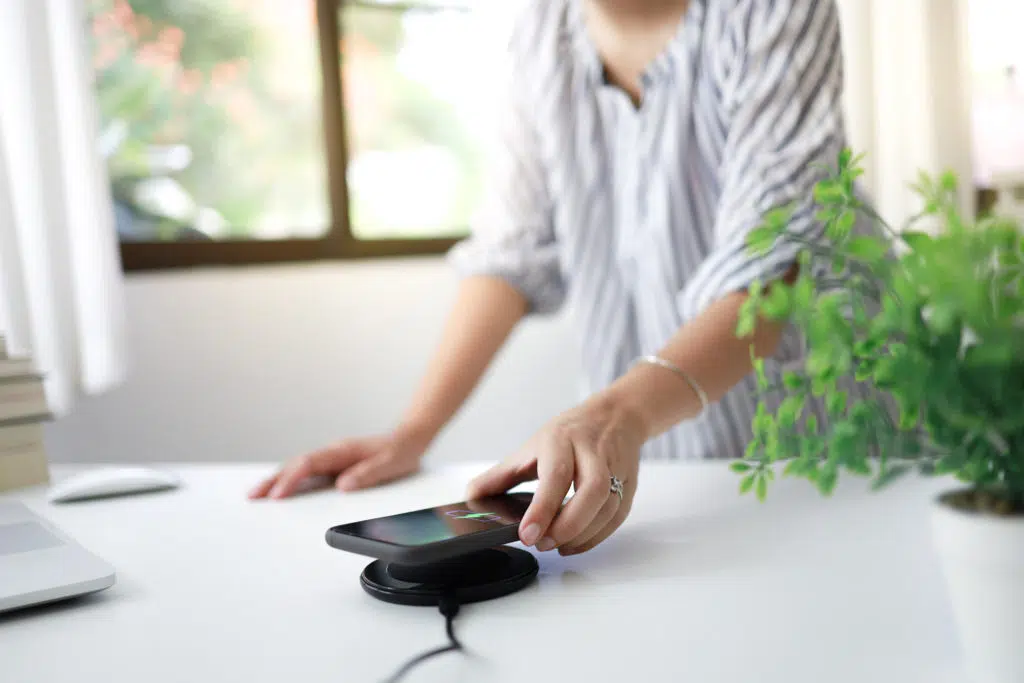Here’s why iPhones and iPads take so long to turn on after dying:
Your iPhone or iPad takes so long to turn on after dying because a bunch of safeguards trip when a phone runs out of battery, so called shutdown and startup cycles.
The Safeguard processes take time to ensure there’s no damage to software or information when the battery dies.
If you want to learn all about what exactly happens during shutdown and startup cycles, then this article is for you.
Keep reading!

Why Do iPhones and iPads Take So Long to Turn On After Dying?

We love our mobile devices.
Smartphones and tablets are incredible instruments that give us so much access to the whole world.
It’s impressive when you stop to think about it.
But, sometimes love can turn sour, especially when the devices don’t work as expected.
Everyone runs their battery to the ground at some point.
In fact, some batteries last longer when you drain them every now and then.
But, when you let your iPhone or iPad go completely dead, it feels like they take forever to come back on.
If they’re plugged into the wall, shouldn’t they just turn right back on?
Well, that’s a more complicated question than it might seem.
Let’s take a few minutes and see what’s really happening and why that delay time exists.
What Are Phone Safeguards?

When a phone gets critically low on a battery charge, a bunch of safeguards trip.
The phone doesn’t just turn off because it’s out of power.
It goes through a regimented shutdown process.
The reverse of that process is equally involved when the phone powers back on.
Why do iPhones and iPads take so long to turn on after dying?
The short answer to this question is that these processes take time to ensure that software and information on the device are not harmed when the battery dies.
What Are the Necessities of Modern Data Storage?

To better understand what is involved, we first have to talk about how iPhones and iPads store information.
Modern iterations of both devices use flash storage.
It’s much faster and more responsive than the older magnetic storage options, which is why it’s so popular.
But, this means that no data can be added or altered without an electric current.
The storage mechanisms are really just complicated circuits, so when your battery is dead, the device mechanically can not write data.
If your phone were to be completely cut off from electricity in the middle of important operations, critical data could not be written.
You wouldn’t just lose your most recent internet search or social media post (although you could lose those too).
Core system functions would fail to complete, and it could damage your software on a fundamental level.
This is why your devices go through the full shutdown cycle when your battery gets too low.
Before it hits 0%, the phone or iPad initiates a shutdown to ensure that all important data is written to completion before the device is truly off.
What Are Shut Down Cycles?

The shutdown cycles themselves carry out important tasks.
They end writing operations, which means that you aren’t left with any loose ends in your data storage.
For a computer, such loose ends can be confusing and impact performance.
Shutdown also ensures that every active app properly saves where it is and ceases operation.
Once again, this prevents broken data storage that could harm performance.
The shutdown cycle itself can take up to a couple of minutes, depending on how many tasks were active and when it was initiated (and how fast the device is in general).
Your device will automatically account for how much battery it needs to save to get through the shutdown.
That’s what determines what percentage you see when the screen goes dark.
It’s not at 0%, or else none of these safety protocols would work.
By the time shutdown completes, you might be left with no charge left in the battery.
Even when you plug the phone in, there isn’t enough charge to power it on right away.
What Are Startup Cycles?

We’ll talk more about charging in a moment, but it makes more sense when you understand startup cycles.
For an iPhone or Ipad to work, there are a lot of applications that operate under the hood.
These applications do things like make the touchscreen responsive, render images, and run the operating system at a logistical level.
There are way too many functions to list, but they account for the hard work that the device has to do behind the scenes to give you a good experience.
These behind-the-scenes apps have to load correctly and in the correct order for the device to work.
For instance, you can’t see the Apple logo telling you that the phone is on until the screen’s hardware controllers have loaded and initiated.
They are what tell the screen what to do, so without them, everything is blank.
The startup cycle has to go through countless operations before you can effectively use your phone or iPad.
And, this is one of the biggest reasons why everything takes so long. When you hit the button, you don’t see the logo right away.
Even after you do, it can still be a bit before the device is fully on and usable, and all of this is because of startup cycles.
How Does Your Phone Ensure a Complete Startup?

Now that you know the phone is doing a lot of work just to turn off or on, things get… a lot simpler.
That last part of the equation is the actual charging time.
Consider the common scenario. You use your phone until it dies.
So, you plug it in and try to hit the power button.
Nothing happens, so you wait a minute and try again. Still, nothing happens.
Sometimes, it takes several minutes before the phone will turn back on.
This is the result of another safety protocol.
The device won’t enter startup until the battery has enough charge to complete both startup and shutdown.
Sometimes, this can be as much as 3% of the total battery.
The point of this safety feature is to make sure your phone doesn’t mess up if the power cuts up while the battery is charging.
If the battery can at least get through all of the essential processes, then it won’t be harmful if the plug falls out or the power to the building dies.
Your core systems and data are protected, and that’s ultimately good for you and the phone.
What this ultimately means is that the device really does have to charge for a bit before it will let you turn it on.
How long this takes depends on a lot of conditions, but it can be anywhere from 30 seconds to several minutes.
How to Minimize the Charging Time?

One of the biggest delays, when you try to turn the phone or iPad back on, is waiting for the battery to charge past the critical safety level.
Rather than be annoyed every time it happens, there are a few things you can do or learn to minimize charging time—especially if you need the device right away.
First, use a fast charger.
Apple makes a number of different chargers, and they all work a little differently.
There are USB chargers, wireless chargers, wall chargers, and plenty more.
When you need juice fast, you want the most powerful charger you can get.
Among those made by Apple, the fastest is the 20W USB charger.
The adapter plugs right into the wall, and it draws more juice.
This will charge your device faster than anything else you can get from Apple right now.
After that, the lower-watt wall adapter and the Magsafe chargers are comparable.
The Magsafe is a little slower, but not by leaps and bounds.
The slowest way to charge a device is by plugging the USB cable into a computer.
That has a much lower draw than caps at 4.5 watts.
Compared to the best charger, it’s about 5 times slower.
There’s one other tip that will help you save time before you reboot. Stay patient.
All electronic devices use capacitors as a bit of a safety mechanism.
Rather than get into the nuts and bolts of capacitors, it’s enough to know that they collect a small charge of electricity that they then pass onto the device.
Every time you hit the power button, you empty the capacitor, and it has to refill before your battery will charge or your device will turn on.
It usually only takes a few seconds to fill the capacitor, but if you’re hitting the power button often, that can add up.

